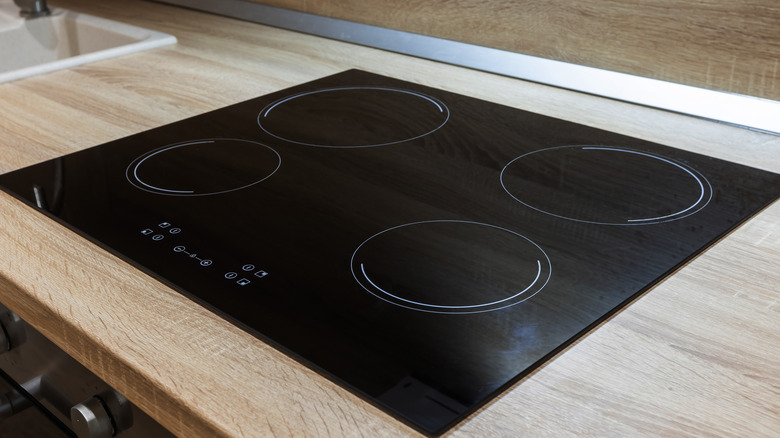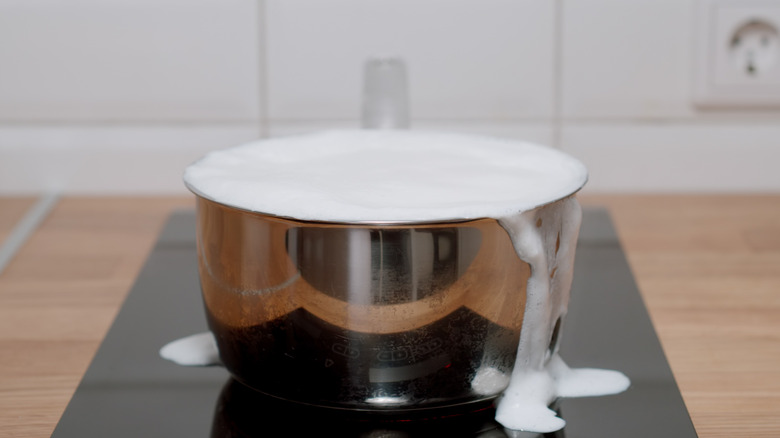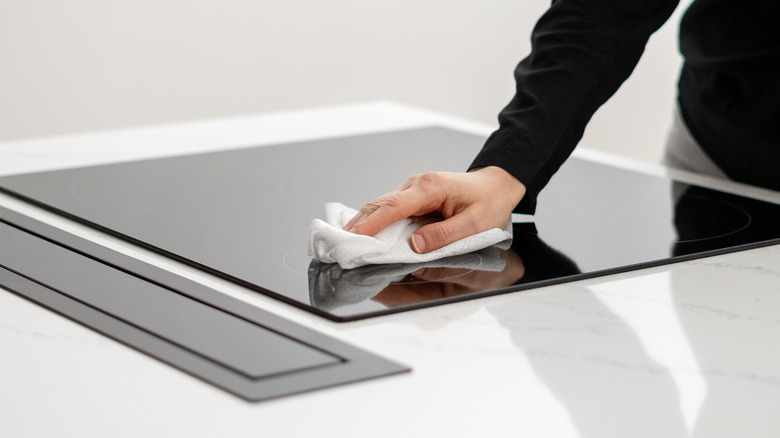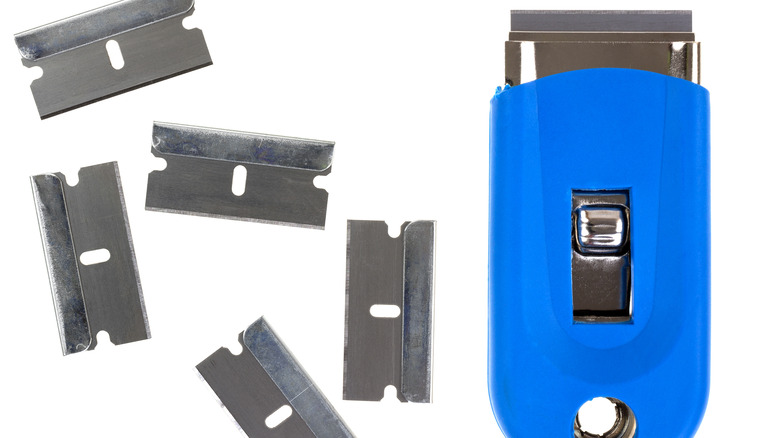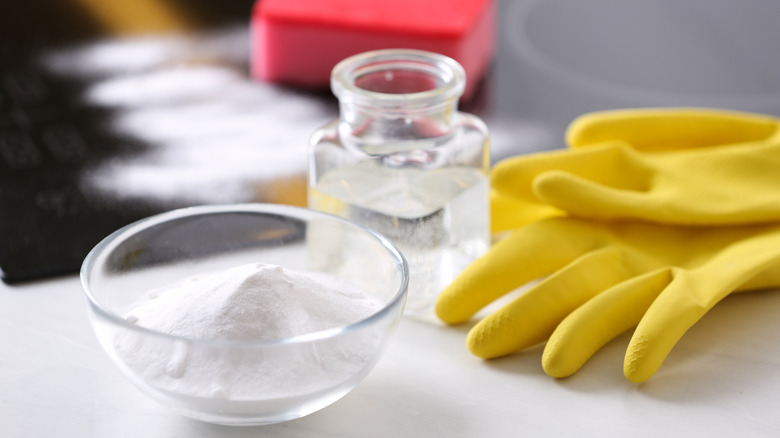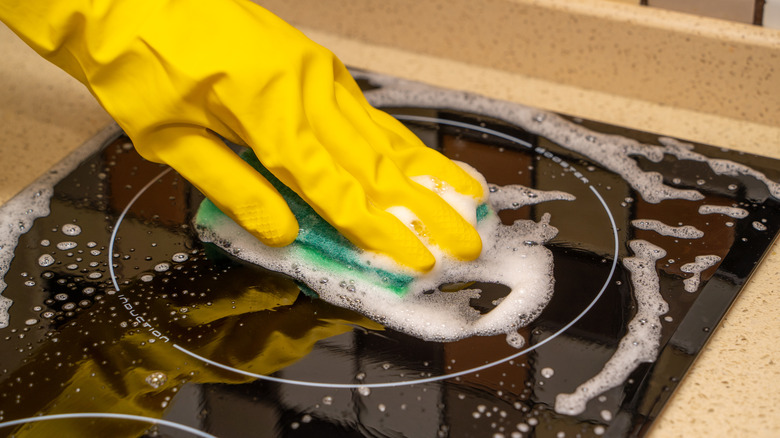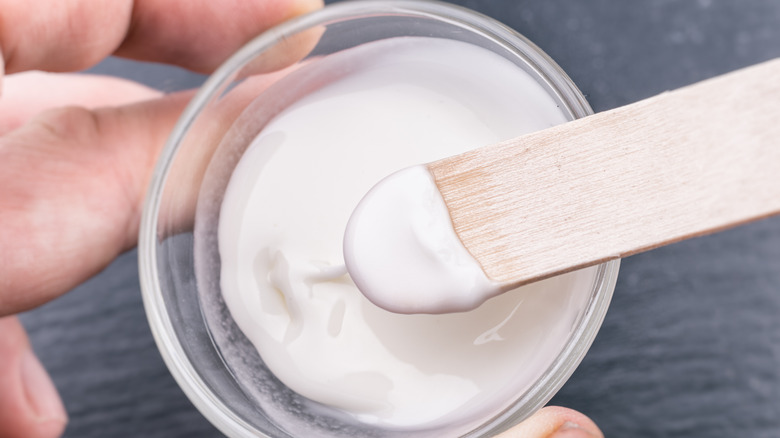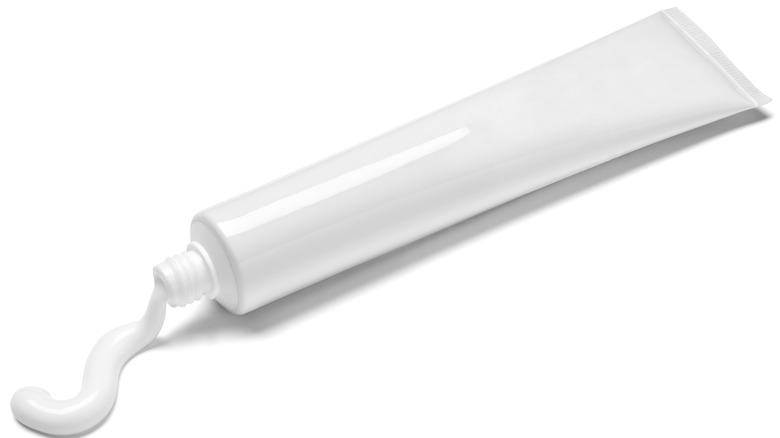8 Easiest Ways To Clean Glass Stove Tops
Glass stove tops offer many advantages like rapid heating, cooling, and the lack of grates and crevices where food can fall into, as noted by The Spruce. Plus, many owners prefer their more modern look as compared to the previous generation's electric stoves with metal coils. Nonetheless, like any appliance, regular, careful maintenance is key to longevity and performance. Such is the case with a glass stove top. Depending on how often you clean its surface and the extent of the mess, the process can take from two short minutes for a quick wipe-up to 30 minutes for a thorough deep cleaning. Regardless of the time you put into cleaning your glass stove top, you'll protect it from permanent damage while keeping the sleek surface free from streaks, scratches, and stains. For cleaning your glass top stove, you'll need to keep the following supplies on hand:
-
spray bottle filled white vinegar
-
some microfiber or some other lint-free, soft cloths
-
baking soda
-
a manufacturer's recommended cleaner (if specified in the instructions)
-
a razor blade
-
a non-abrasive scrubbing pad
-
toothpaste
As you will see, these eight easy methods will take the fuss out of cleaning your glass stove top.
1. Follow the manufacturer's instructions
The easiest method for cleaning your glass stove top is to follow your owner's manual, as noted by This Old House. Not only is this the simplest option for everything from the smallest smudge to a major mess, but also the safest. In fact, most appliance brands have their own products or a list of recommended products for cleaning minor spills off of your glass stove top on a daily basis. Furthermore, some manufacturers have created their own deep cleaning formulas that are non-abrasive as well as their own tools for the job, such as a scraper or wipes.
Regardless of the suggested products and methods that your manual prescribes, you can rest assured that the company that created the appliance wouldn't give you bad advice for cleaning your glass stove top. More importantly, you might consider reading the fine print of your warranty to make sure that following the manufacturer's methods guarantees coverage if something were to go wrong.
2. Tackle spills after each use
Aside from following the manufacturer's instructions, the easiest way to clean your glass stove top is to mop up spills right away. (However, don't forget to wait until the glass top cools off enough to where it's safe to touch.) As mentioned, you can refer to the appliance's instructions to carry this out safely without damaging the stove top. Also, if you don't have the manual handy, you can follow these steps that are mentioned in Whirlpool's blog.
-
Spritz the affected area with white vinegar.
-
Mop up the spill with a damp, soft cloth.
-
Wipe a few more times with a sponge or soft paper towel to erase the streaks.
You can also soak up the spilled liquid with a soft paper towel or sponge without spraying with vinegar if it looks like it won't leave a stain or streak. However, the key is to address the spill as soon as possible after the stove top cools to avoid a stain that requires scraping.
3. Clean your glass stove top daily
Another easy method for keeping your glass stove top clean is to tackle your daily maintenance after dinner once you've finished cooking for the day, as recommended by HGTV. From there, you would simply follow the steps from the previous method.
However, you'll be cleaning the entire surface as opposed to just one spot. Again, make sure the glass top has cooled off completely before spraying it with white vinegar. The best approach is to take the stove top one section at a time, mentally dividing it into four sections. For instance, you'll spray the upper left quadrant first and then wipe off the stains with a soft, damp cloth. Next, you'll proceed to the upper right corner and so forth until you've covered all four quadrants of the stove top. As you wipe off the vinegar, you'll go over the area with a dry microfiber cloth or a clean cotton rag (like part of a t-shirt) to polish off any streaks or spots.
4. Use a scraper for deep cleaning
Along with daily maintenance, you'll need to do a periodic deep cleaning. However, if you've waited a while in between cleanings, you might have to resort to the scraper method. Although you have to take extra care to avoid leaving scratches or damaging your glass stove top, this method is still quite easy if you have the right tools and follow these steps as outlined by Pro Housekeepers:
-
Spray all stains with white vinegar and allow them to soak.
-
Take a razor blade and hold it almost flush to the surface.
-
Carefully scrape off the stain using light, short strokes.
-
Wipe the area clean with a soft cloth.
Most glass top stoves come with their own scraping tool and their own set of instructions for deep cleaning. So make sure you follow that process carefully. Also, you might wipe down the glass stove top one more time using the white vinegar for any leftover stains before a final polishing with a microfiber cloth.
5. Soak up stains
If you don't want to risk getting scratches by scraping, then you can use the soaking method for deep cleaning your glass stove top. You'll take a bowl and fill it with about 1/2 cup of hot water or less and mix with baking soda to create a paste. Next, you'll spread the paste over your glass stove top and cover with hot wet cloths. Let them sit for half an hour and then wipe the surface clean. If the paste has hardened, you can spray a bit of white vinegar to soften it up and then wipe.
An alternate method, as described by Bob Vila, is to fill your sink with hot water and add a small amount of dishwashing liquid and mix thoroughly. Then immerse a soft cloth into the mixture. After that, you'll sprinkle the baking soda onto the stove top, and take the wet cloth from the sink, wring it out, and spread it over the baking soda. This will moisten the baking soda and allow it to soften up the stains. At this point, you'll wait for about half an hour before removing the cloth. Then, you'll immerse the cloth into the hot water and wring it out again and use it to gently wipe off the stains. For additional buffing, wipe with a damp sponge and dry with a soft cloth.
6. Clean burnt-on stains
Once in a while, you'll get stains caused by thick, sticky foods or liquids. Consequently, you'll need to be careful not to let the substance cool completely because it'll leave permanent stains on your glass stove top or solidify into a permanent lump. So cleaning the spill while your stove is still warm but not hot is the ideal option. Therefore, you might have to revert back to the scraper, but you'll need a non-abrasive cleaner specifically for a glass stove top instead of the white vinegar or baking soda — a tip that's also recommended by Whirlpool's blog.
So the first step is to gently scrape the spill holding the scraper at a slight angle. Then apply the cleaner in small, dime-size dots on the stain and wipe it in until you see a white film over the spill. Then using a soft cloth, you'll buff off the film until it's completely gone. For tougher stains, you might have to repeat the treatment.
7. Clear up scratches
Removing scratches proves to be just as easy as preventing them, per Essential Home and Garden. First, you'll mix up a paste of baking soda and water that's similar to the one you would use to soak up stains. This time, however, the paste won't have as thick of a consistency. Plus, you'll need to gently apply the paste using a damp cloth. Afterward, you'll gently buff the surface. You won't completely erase the scratches, but after this treatment, they'll appear less visible. Of course, for more serious scratches, you might need to contact an expert to repair or replace the surface.
Another tip to remember is to avoid using glass cleaner or a Magic Eraser on scratches as they might not work at the very least, or at worse, they might leave a permanent discoloration or film on the glass. You can also avoid scratches altogether by refraining from using cast iron cookware and by not dragging or banging pots and pans on the surface.
8. Clean using the toothpaste method
Of course, we've saved the best method for last. If you don't feel confident about mixing up a paste that's not abrasive, or you're strapped for time, you can also use plain toothpaste (avoiding the formulas that contain gel or other sticky ingredients) to clean up tough stains, according to Essential Home and Garden. After applying the toothpaste with a soft sponge, you'll need to wait for 15 minutes to allow it to absorb the stain. Then, wipe it off gently with a damp, soft cloth.
As you can see, keeping a clean glass stove top on a regular basis increases the life of your appliance. Specifically, if you wipe up spills immediately (after cooling of course), you're looking at less scraping and wiping which, if you're not careful, can damage the surface. However, if you stay with daily or even weekly maintenance by using soft cloths, white vinegar, or the manufacturer's brand of cleaner, you'll enjoy worry-free cooking on your glass top stove for years to come.
